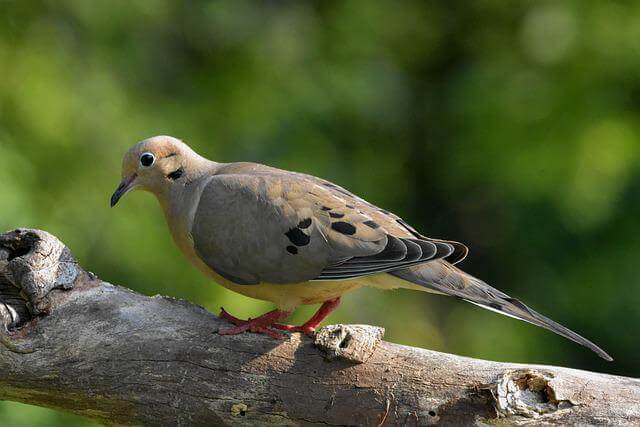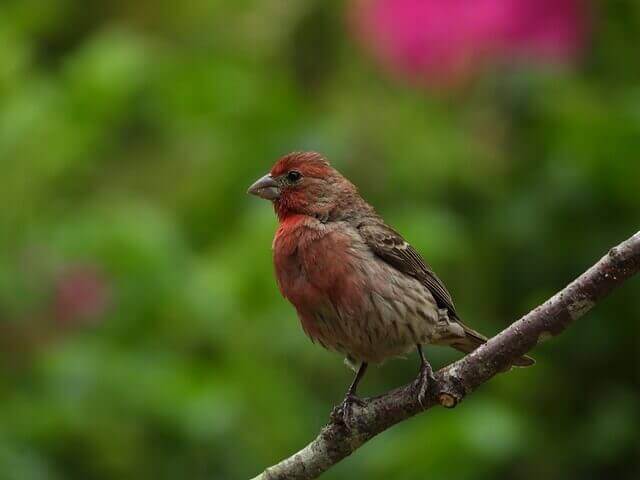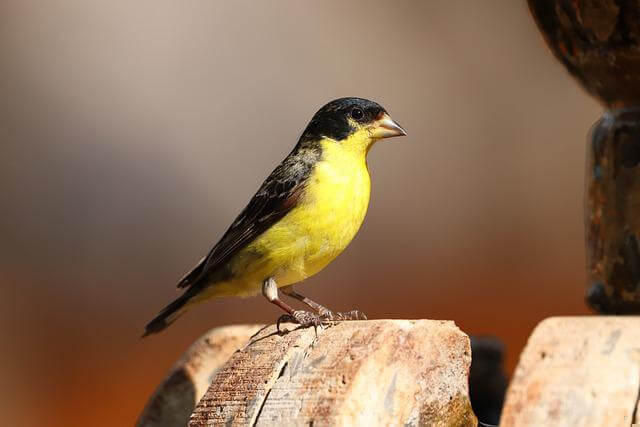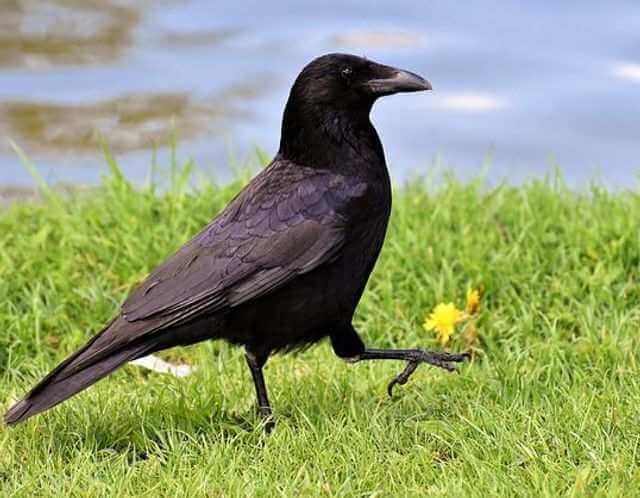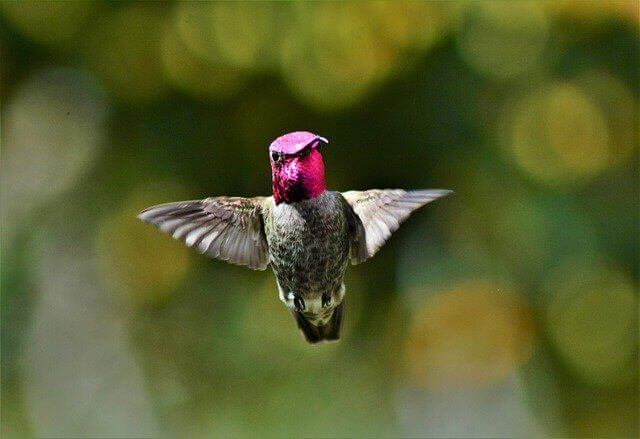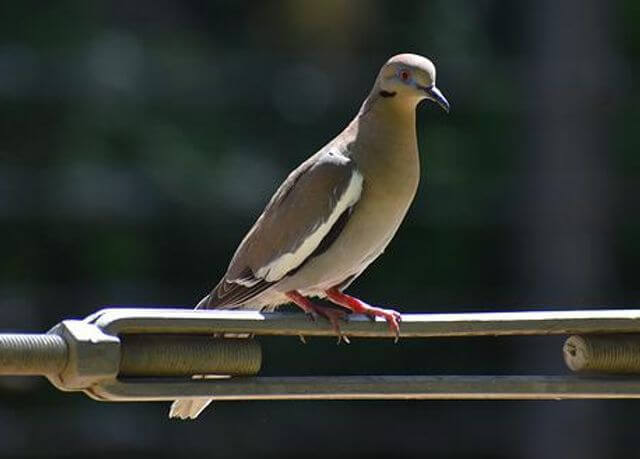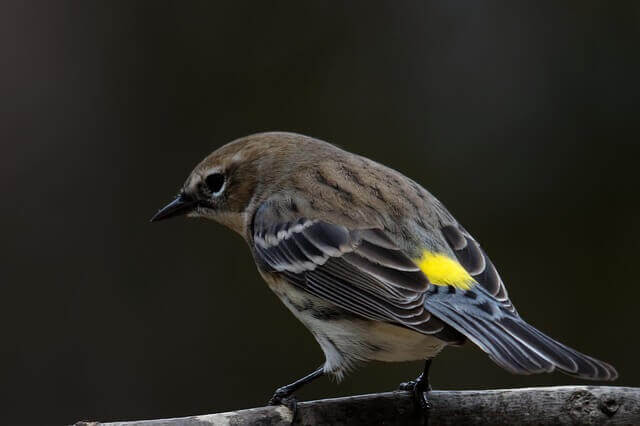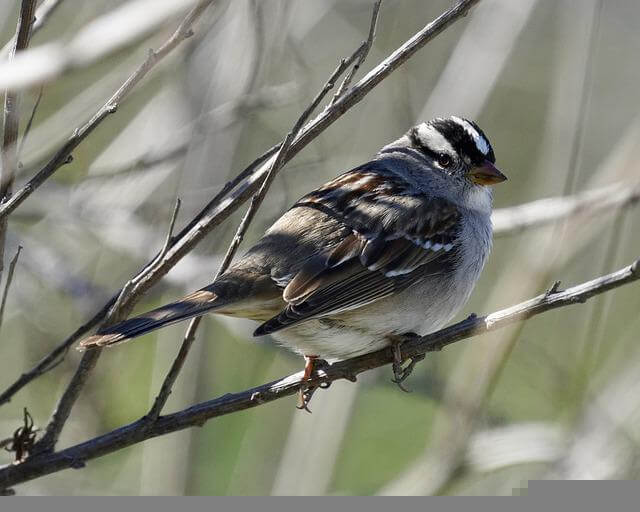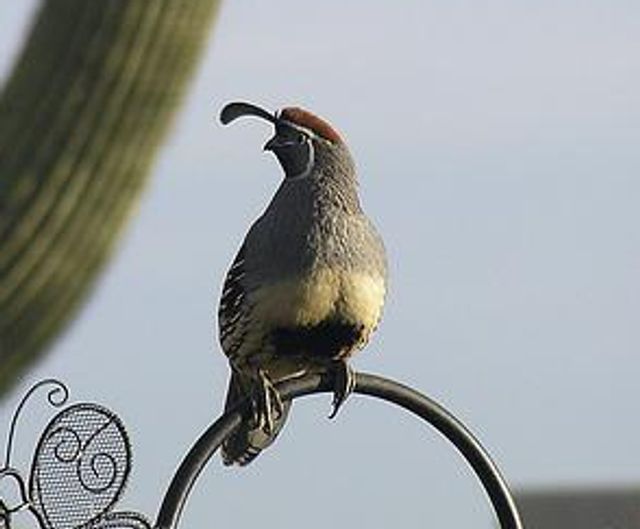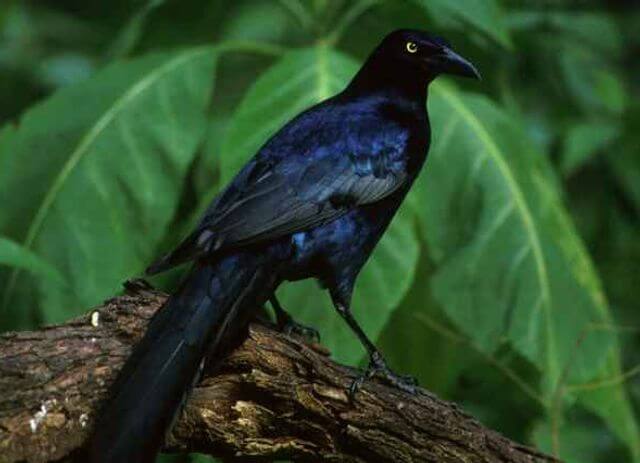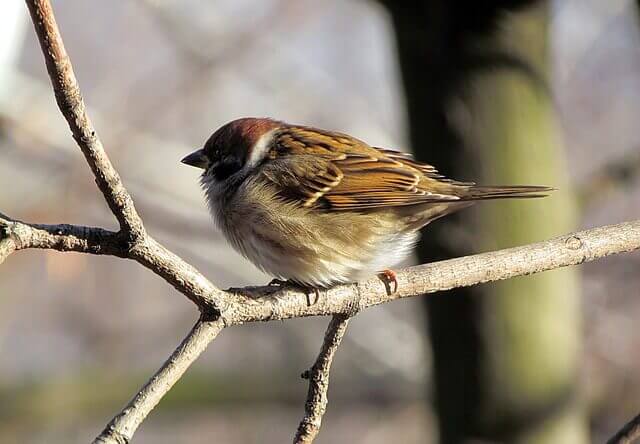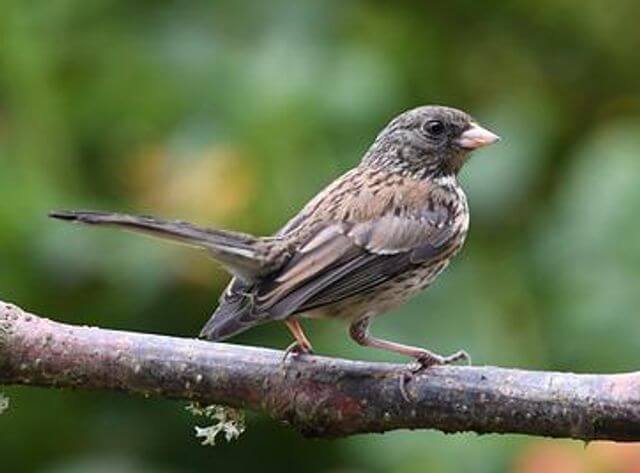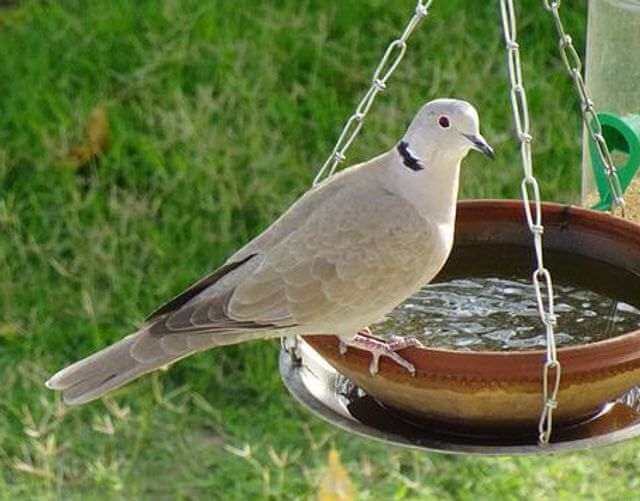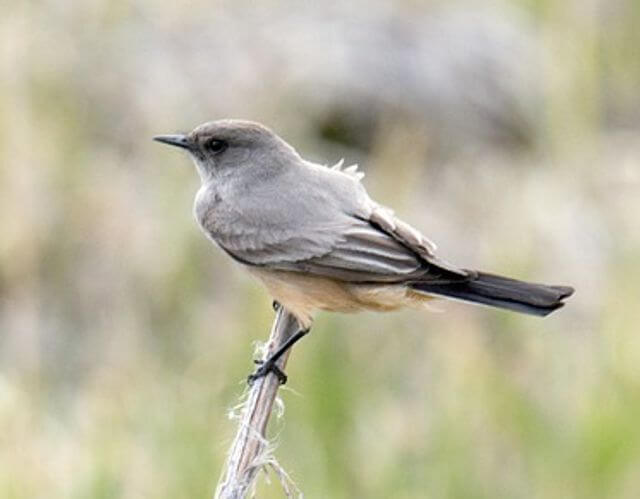Arizona is a paradise for bird lovers, but have you ever wondered which species you’re most likely to see? From the dazzling Anna’s hummingbird to the soaring red-tailed hawk, the state is home to an incredible variety of birds. Whether you’re exploring the Sonoran Desert or relaxing in your backyard, you’ll find plenty of feathered visitors. In this guide, we’ll explore the 38 most common birds in Arizona and how to identify them.
Don’t forget to get your FREE birdwatching checklist for Arizona to enhance your birdwatching experience!
Click the Play button below to listen to our podcast:
Table of Contents
- 1 Most Common Birds in Arizona
- 1.1 Mourning Dove
- 1.2 House Finch
- 1.3 Gila Woodpecker
- 1.4 Lesser Goldfinch
- 1.5 Verdin
- 1.6 Common Raven
- 1.7 Anna’s Hummingbird
- 1.8 White-winged Dove
- 1.9 Curve-billed Thrasher
- 1.10 Yellow-rumped Warbler
- 1.11 White-crowned Sparrow
- 1.12 Gambel’s Quail
- 1.13 Great-tailed Grackle
- 1.14 House Sparrow
- 1.15 Abert’s Towhee
- 1.16 Northern Mockingbird
- 1.17 Eurasian Collared-Dove
- 1.18 Ladder-backed Woodpecker
- 1.19 Black Phoebe
- 1.20 Say’s Phoebe
- 2 Frequently Asked Questions
- 2.1 What is the most common bird in Arizona?
- 2.2 How many types of birds are in Arizona?
- 2.3 What are the loud birds in Arizona?
- 2.4 What are the black birds in Arizona called?
- 2.5 What kind of finches live in Arizona?
- 2.6 Are there wild parakeets in Arizona?
- 2.7 Are there osprey in Arizona?
- 2.8 Are there blue jays in Arizona?
- 2.9 What birds nest on the ground in Arizona?
- 2.10 Are there wild love birds in Arizona?
- 2.11 What are the small black birds in Arizona?
- 2.12 What bird sings at night in Phoenix?
- 2.13 Are there Mockingbirds in Arizona?
- 3 Author
Most Common Birds in Arizona
Mourning Dove
The Mourning Dove is a small, non-migratory bird that lives in North America. The range of the Mourning Dove extends from Canada to Central America and includes much of the United States. The dove can be found in many habitats including forest edges, fields with low vegetation, dry scrubland, urban areas such as parks and gardens or even around human dwellings.
Mourning Doves eat mainly seeds and grains, but will also feed on berries or other fruit when available. They migrate during winter months to avoid harsh weather conditions and food shortages
- Frequency of Occurrence: 47.01% year round (Statistic by: eBird)
- Color: Light gray-brown and lighter and pinkish below. The wings have black spots.
- Habitat: Open habitats, urban areas, farms, prairie, grassland, wooded area
- Range: USA, Canada, Mexico, Central America, Greater Antilles
- Size: 12″ inches long
- Weight: 112 – 170 grams
- Diet: Rapeseed, corn, millet, safflower, sunflower seeds, pokeberry, sesame, and wheat.
- Family: Columbidae
- Genus: Zenaida
Related Posts: 10 Facts about Mourning Doves
House Finch
House Finches are very common birds in North America. They range from the East Coast to California and can be found as far north as Alaska. These beautiful little birds typically live in suburban areas, farmland, and open fields with scattered trees or shrubs.
They feed on seeds, grains, fruits and berries. In the winter months they move to warmer climates in search of food sources such as insects and weed seeds. House finches migrate annually south for wintering seasons, while some stay in warmer climates year-round.
- Frequency: 45.94%
- Color: Reddish face and upper breast, brown streaks on back, belly, and tail.
- Habitat: urban and suburban areas, backyards, edges, yards, and parks
- Range: Canada, USA, Mexico
- Size: 5 – 6″ inches long
- Weight: 16 – 27 grams
- Diet: Aphids, grains, seeds, berries, nettle, dandelion, sunflower
- Family: Fringillidae
- Genus: Haemorhous
Related Post: How to Attract House Finch to your Yard
Gila Woodpecker
The Gila Woodpecker is a member of the woodpecker family. They are found in forested areas, pine forests and deserts from Mexico to Arizona and New Mexico.
These birds can be seen all over Arizona and are very colorful and beautiful birds. They are considered to be one of the most fascinating birds, due to their unique songs.
Inhabiting forested areas, this species will also venture into other habitats such as oak groves, oak-juniper forests, chaparral shrublands, desert canyons and pinyon pine forests. The bird eats mostly insects, as well as tree sap, spiders, scorpions, centipedes and even other small birds.
- Frequency: 34.02%
- Color: Grayish brown with a zebra pattern on the back, wings, and tail. In-flight, the external wings are dark with a white crest
- Habitat: Desert rivers, towns, and suburbs.
- Range: Southwestern United States and western Mexico. They range through Arizona, New Mexico southeastern California, southern Nevada,
- Size: 10 -12″ inches long
- Weight: 65 grams
- Diet: Cactus fruit, insects, wild fruit, berries of shrubs and small lizards, earthworms, eggs, mistletoe, nectar, flowers, seeds, and young small birds
- Family: Picidae
- Genus: Melanerpes
Lesser Goldfinch
The Lesser Goldfinch is a bird of the finch family. It breeds in parts of North America, Europe and Asia and has been introduced to other areas. This passerine bird’s breeding range stretches from southern Canada to central Mexico, as well as Bermuda and the Caribbean islands.
They live in open fields, prairies, meadows, orchards and parks where they can find grasses for seeds or weed seeds that will produce a large variety of plants for their diet. They migrate southward during winter months when food becomes scarce.
- Frequency: 31.47%
- Color: Bright yellow underparts, white patches on the tail and wings
- Habitat: Almost any habitat with trees or shrubs, backyards
- Range: Southwestern United States, Washington, Peru, Venezuela
- Size: 3.5 – 4.7″ inches long
- Weight: 8 – 12 grams
- Diet: Tree buds and weed seeds
- Family: Fringillidae
- Genus: Spinus
Verdin
The Verdin bird is a small bird that lives in the Western United States. It can be found from California to Texas and as far north as Nebraska. The Verdin is found primarily in open grasslands, deserts, shrublands and semi-deserts, but will occasionally venture into riparian woodlands or chaparral habitats.
It feeds on insects such as beetles, grasshoppers, caterpillars and spiders as well as seeds, berries, flowers and nectar from plants such as thistles, ragweed and milkweeds. They are monogamous breeders who migrate south during winter months and return north when spring arrives.
- Frequency: 30.39%
- Color: Bright yellow head and reddish-brown shoulder patch
- Habitat: Sonoran Desert, mesquite bosques, urban areas
- Range: Desert Southwest of the United States and Mexico
- Size: 4.5″ inches long
- Weight: 6.8 grams
- Diet: Mainly insects
- Family: Remizinae
- Genus: Auriparus
Common Raven
The Common Raven is commonly found in the southwestern part of North America. The Common Raven usually feeds on small insects and seeds.
It can also eat small carrion and birds, small mammals like mice and bats, worms and frogs. It can be found in the southern part of Arizona, including the deserts of Phoenix, Maricopa, Pinal, and Yuma counties.
The best time to observe them in Arizona is between April and June. In the southern part of the state because this is when the breeding season for the species occurs. The male is at its peak during this time.
- Frequency: 27.35%
- Color: All black iridescent plumage
- Habitat: Wooded areas, evergreen forests, tundra, roadside, grasslands, backyards, parks
- Range: Found throughout the Northern Hemisphere
- Size: 21 – 26 inches long
- Weight: 1.5 – 4.5 lbs.
- Diet: Mainly scavengers, feeding on carrion, beetles, and maggots.
- Family: Corvidae
- Genus: Corvus
Related Post: 18 Fun Facts About Ravens
Anna’s Hummingbird
Anna’s Hummingbird is actually a medium-sized bird species belonging to the family Trochididae. Anna’s Hummingbird is one of the smallest among its family, and it can be easily recognized due to its iridescent colors. In addition, it also has a very long tail, and it is also capable of fluttering and making a low buzzing sound.
One of Anna’s Hummingbirds’ characteristics is that it is capable of producing two different types of songs, which are called the trilled and the humming song. They also can produce a loud, high-pitched call.
One of Anna’s Hummingbird’s other common characteristics is that it lives in large trees and branches. It also tends to eat nectar, insects, and fruits that it finds during its travels.
- Frequency: 23.99%
- Color: Bronze-green iridescent back, a gray chest and belly, and green flanks
- Habitat: Open woodland, chaparral, coastal scrub, oak savannahs, backyards
- Range: Western coast of North America, Southern Canada, Northern Baja California, Arizona, Nevada, Utah, Texas.
- Size: 3.9 – 4.3″ inches
- Weight: 3 – 6 grams
- Diet: Nectar, flowers, and insects
- Family: Trochilidae
- Genus: Calypte
Related Post: Where do Hummingbirds go in the winter?
White-winged Dove
The White-winged Dove typically flickers or glides along at high altitudes, sometimes reaching as high as 2 miles. They feed on seeds, nectar, insects, grasses, and sometimes berries. This species likes to feed at dawn and dusk, especially during summer.
If you are in the Phoenix area, you should also be able to see them around Sky Harbor. They are also known to use a large part of Sky Harbor property as a feeding ground.
The best time to see the White-winged Dove is late May through late September. During this time, the weather is warm, and the birds will be less likely to migrate north.
- Frequency: 22.57%
- Color: Brownish-gray upper body and gray under, has a white crescent patch on wings
- Habitat: Grasslands, river woods, mesquites, saguaros, groves, towns, brushlands, deserts chaparral, farmland, suburbs, citrus grove
- Range: Arizona, Texas, San Antonio, Kansas, Arkansas, Oklahoma, Mississippi, and northern New Mexico Mexico, Central America, and the Caribbean.
- Size: 11″ inches
- Weight: 150 grams
- Diet: Seeds, grains, and fruits
- Family: Columbidae
- Genus: Zenaida
Related Article: Best Bird Feeder For Doves (Reviewed & Tested for 2022)
Curve-billed Thrasher
The Curve-billed thrasher is a species of bird in the Mimidae family. The Curve-billed thrasher’s range includes much of western North America, Central America and northern South America.
The Curve-billed Thrasher can be found all over Arizona in the northern and southern regions. This bird’s habitat can be found in open habitats such as deserts, savannas, scrublands and grasslands.
They are most often seen near water sources where they feed on insects like beetles, crickets and grasshoppers as well as berries when available. It migrates seasonally during winter to warmer climates like southern California and Texas.
- Frequency: 22.39%
- Color: Brownish-gray upper body and gray under, has a white crescent patch on wings
- Habitat: Woodland edges, piñon, dry desert bushland and backyards, areas where there are cacti
- Range: Desert regions of the United States and Mexico
- Size: 10.5 – 11″ inches
- Weight: 60 – 93.5 grams
- Diet: Invertebrates such as beetles, moths, butterflies, arachnids, snails.
- Family: Mimidae
- Genus: Toxostoma
Yellow-rumped Warbler
The Yellow-rumped Warbler is a common bird found in the eastern United States. They are usually found near water, and can be seen during the summer months. These birds migrate to Central America for the winter, making their way back north as early as February.
They live in areas with open spaces like forests and meadows. They can be seen during migration near lakes, rivers, or fields where they feed on insects such as mosquitoes, beetles, and flies; however, they also eat spiders and even berries.
This diet helps them get through their migration time period, where food may not be readily available due to changes in weather. During the winter months when food becomes scarce, they will go to Mexico for warmer weather and return north during the spring
- Frequency: 22.19%
- Color: Yellow patches on the crown, flanks, rump & blackish-blue streaks on the back, breast, and wings
- Habitat: Deciduous forests and thickets, roadside, grasslands, backyards
- Range: U.SA, Canada, Mexico, Central America, and the Caribbean
- Size: 4.7 – 5.9″ inches long
- Weight: 10 – 18 grams
- Diet: grasshoppers, gnats, aphids, caterpillars, wasps, beetles, spiders, berries,
- Family: Parulidae
- Genus: Setophaga
Related Post: How to Attract Warblers to your Yard?
White-crowned Sparrow
The White-crowned Sparrow is a small bird that is found in the Pacific Northwest region of North America. It can be found from southern Alaska, through Washington and Oregon, into northern California.
They inhabit grasslands, brushy areas, mixed woodland edges, coniferous forests and occasionally residential areas during migration. The White-crowned Sparrow’s diet consists mainly of insects, but they also eat seeds from wildflowers or fruits from trees like apples.
In wintertime, these birds migrate to Central America for warmer weather and dryer climates, returning northward during spring migration season when it’s time to breed
- Frequency: 21.87%
- Color: Black and white stripes on their head, gray face, brown-streaked upper, and a long tail. Brown wings with bars and the underparts are gray.
- Habitat: Brushy areas
- Range: Western USA, and Northern Canada
- Size: 5.9″ – 6.3″ inches long
- Weight: 25 – 28 grams
- Diet: Seeds, insects, and plants
- Family: Passerellidae
- Genus: Zonotrichia
Gambel’s Quail
Gambel’s quail are a medium-sized ground bird, with the males being more brightly colored than females. They live in brushy habitats and can be found across North America from California to Nova Scotia, Alaska to Florida.
They live in sparse vegetation, brush, open shrublands, grasslands, and desert areas with scattered cacti. They feed on seeds, berries, and insects such as ticks and ants.
It migrates southwards, as far as Guatemala during the winter when the temperature drops below 20 degrees Fahrenheit (-6 Celsius) because there is not enough food for them to survive on
- Frequency: 21.55%
- Color: Reddish-brown crest, chestnut flanks with white stripes, and cream-colored belly with a black patch
- Habitat: Brushy areas, deserts, rivers, valleys, backyards
- Range: Desert areas of Arizona, California, Colorado, New Mexico, Nevada, Utah, Texas, Sonora, New Mexico, Colorado River, Baja California.
- Size: 9.8 – 11″ inches long
- Weight: 160 -200 grams
- Diet: Seeds, insects, fruits, berries, and plants
- Family: Odontophoridae
- Genus: Callipepla
Related Article: How To Attract Quail To Your Yard? Expert Tips!
Great-tailed Grackle
The Great-tailed Grackles is a medium-sized bird that is native to Mexico but was introduced into the United States, and has been slowly taking over the state. They are very active birds that will fly from tree to tree. They can be found in nearly any habitat in Arizona, as they tend to adapt to almost any environment they find themselves in.
The Great-tailed Grackle in Arizona are quite adaptable and are often able to survive on very limited food resources. Although the bird may not have the same nutritional needs as some species, they tend to eat grasses, seeds, small insects, and grubs. They are also able to eat small rodents, birds, squirrels, and even snakes.
It is found along the banks of rivers and streams in a variety of habitats and is often seen along the banks of creeks, and rivers in the desert regions. Some people even believe that it lives on a variety of islands in Mexico and Central America. They are also known to inhabit rocky cliff sides and cliffs in Arizona.
- Frequency: 21.43%
- Color: Iridescent black with a purple-blue sheen
- Habitat: Pastures, wetlands, mangroves, backyards
- Range: Minnesota, Oregon, Idaho, California, Florida, Southern Canada, Mexico, Venezuela, Ecuador.
- Size: 15 -18″ inches long
- Weight: 200 – 265 grams
- Diet: Seeds, insects, fruits, berries, larvae, eat lizards, nestlings, and eggs
- Family: Icteridae
- Genus: Quiscalus
House Sparrow
The House Sparrow (Passer domesticus) is a small bird of the sparrow family. It is native to most of Europe, Africa and Asia, as well as northwest South America.
The house sparrow lives mainly in cities or towns where it can find food on the ground, as well as many other types of habitats such as agricultural land, wetlands and open country with few trees.
It eats seeds from cereal crops like wheat and barley, but also insects like beetles and caterpillars. There are some populations that migrate south for winter or away from drought-affected areas; however, they do not follow any specific migratory pattern like other birds do
- Frequency: 20.11%
- Color: Gray head marking, a reddish-brown back, and gray underparts
- Habitat: Urban centers, suburban areas, backyards, edges, yards, and parks
- Range: North America, Central America, South America, Africa, Australia, New Zealand
- Size: 5.5 – 7.1″ inches in length
- Weight: 25 – 39 grams
- Diet: Insects, beetles, caterpillars, aphids,, grasshoppers, crustaceans, earthworms, vertebrates
- Family: Passeridea
- Genus: Passer
Related Post: How to Attract House Sparrows to your backyard?
Abert’s Towhee
The Abert’s Towhee is a type of sparrow found in North America. Its range includes much of the eastern half of the United States and most of Canada.
They are migratory birds that typically spend their winters in southern states like Florida, Georgia, Alabama, Louisiana and Texas before returning to more northern locations during spring. The habitat for Abert’s Towhee consists mostly of woodlands with shrubs or bushes for nesting sites.
These birds also enjoy habitats with a variety of forest types such as oak, pine, mixed deciduous or hardwood. The diet of the Abert’s Towhee consists mainly of insects such as grasshoppers, crickets, seeds, berries and fruit.
- Frequency: 19.93%
- Color: Has a long tail, dark face with brown plumage
- Habitat: Brushy habitats, suburban areas, lower desert areas
- Range: Arizona, California, Nevada, Utah, New Mexico, Sonora Mexico
- Size: 8.3 – 9.8″ inches
- Weight: 40 -54 grams
- Diet: Seeds, insects, berries, and grubs
- Family: Passerellidae
- Genus: Melozone
Related Article: How to Attract Towhee to your Backyard? Expert Tips!
Northern Mockingbird
There are two main locations to see the Northern Mockingbirds in Arizona.
The first one is Maricopa County and the second one is Pima County. All Mockingbirds have a breeding season that runs from late spring until early summer.
During this time, they will travel between the continental divide and Mexico and back to their own breeding grounds. After the migration, the birds come back to their original breeding grounds to lay their eggs.
- Frequency: 17.82%
- Color: Gray upper with white underparts. Black and white wing bars.
- Habitat: Forested areas, parks, and gardens
- Range: Southeastern Canada, USA, Northern Mexico, Cayman Islands, Greater Antilles
- Size: 8.0 – 11″ inches
- Weight: 40 – 58 grams
- Diet: Berries, fruits, seeds, arthropods, earthworms, and occasionally lizards
- Family: Mimidae
- Genus: Mimus
Related Post: How to Attract Northern Mockingbirds to your yard?
Eurasian Collared-Dove
The Eurasian-collared Dove is an avian species native to Asia and Europe; it is now widely distributed worldwide. In the United States, the Eurasian-collared Dove is restricted primarily to the southeast United States, including Florida and the south-central United States.
However, it is now spreading to the west coast from California to Texas. This bird is very territorial, and lives in very common places such as gardens and parks, but can also occur in small flocks in wooded areas and abandoned buildings.
The birds generally congregate near food sources, where they feed on carrion, insects, and fruit. The young birds have a tendency to move from one territory to another to build a strong pair, but this may be temporary.
- Frequency: 16.76%
- Color: Pinkish-gray with a black half-collar bar with white on its neck
- Habitat: Urban centers, farms, backyards, edges, yards, and parks
- Range: North America, Central America, South America, Europe, Asia
- Size: 13″ inches
- Weight: 150 grams
- Diet: Millet, milo, sunflower, wheat, corn, and berries
- Family: Columbidae
- Genus: Streptopelia
Ladder-backed Woodpecker
The Ladder-backed Woodpecker, Picoides scalaris, is a bird of the woodpecker family. They are mostly found in North America and Central America. The ladder-backed woodpeckers range stretches from Canada to Mexico and eastward into the United States as far south as New Jersey.
The Ladder-backed Woodpecker has a variety of habitats it lives in including: coniferous forests, deciduous forests with mixed oak trees, and pine forests. The ladder-backed woodpecker is known for its unique call, which sounds like “kik kik kik”.
They are also well known for their characteristic drumming on trees to communicate with other birds, and they do this during both day and night. Their diet consists mainly of insects such as ants and beetles, but they also eat fruits from time to time.
- Frequency: 16.43%
- Color: Pinkish-gray with a black half-collar bar with white on its neck
- Habitat: Urban centers, farms, backyards, edges, yards, and parks
- Range: North America, Central America, South America, Europe, Asia
- Size: 13″ inches
- Weight: 150 grams
- Diet: Millet, milo, sunflower, wheat, corn, and berries
- Family: Picidae
- Genus: Dryobates
Black Phoebe
The black Phoebe belongs to the tyrant-flycatcher family, which includes some of the most beautiful species in the world. It is found in southeastern Oregon and California, east through Central America and southward into Central Mexico.
Its southern ranges are mostly migratory and occur year-round throughout its entire range, but it does occur more seasonally in its northern ranges, where it only migrates less.
The Black Phoebe bird can be seen in some natural areas and is commonly found near rivers, ponds, and lakes. They are very active and tend to nest in caves and small hollowed out trees.
- Frequency: 16.17%
- Color: Has a black plumage, with white on its belly and under the tail.
- Habitat: Coastal cliffs, river/lake banks, parks
- Range: West and Southwest United States, Mexico, Central America, South America,
- Size: 6.3″
- Weight: 16 – 22 grams
- Diet: Beetles, wild bees, wasps, flies, moths, caterpillars, crickets, grasshoppers.
- Family: Tyrannidae
- Genus: Sayornis
Say’s Phoebe
Say’s Phoebe is a bird found in North America. The range of Say’s Phoebe is from the Pacific coast to Central Mexico and west Texas. Say’s Phoebe live in grasslands, deserts, orchards, agricultural fields and suburban areas.
It also lives near streams, lakes and ponds with trees or shrubs nearby. The Say’s Phoebe Diet consists of insects like ants, grasshoppers, invertebrates and spiders which they catch with their bill or pick up off the ground.
The birds will migrate south during winter months for warmer weather, but they stay north for summer because it stays warm enough at higher altitudes.
- Frequency: 16.14%
- Color: Pinkish-gray with a black half-collar bar with white on its neck
- Habitat: Farmland, savanna, and open woodlands, close to the water
- Range: Arizona, Colorado, California, Texas, North Dakota, Massachusetts, Alaska, Canada, Mexico
- Size: 7.5″ inches
- Weight: 21 grams
- Diet: Insects, seeds, nectar, and berries
- Family: Tyrannidae
- Genus: Sayornis
The backyard birds, below, have a frequency of occurrence of less than 16% year-round.
- Ruby-crowned Kinglet
- Cactus Wren
- Bewick’s Wren
- Northern Flicker
- Northern Cardinal
- European Starling
- Phainopepla
- White-breasted Nuthatch
- Vermilion Flycatcher
- Red-winged Blackbird
- Rock Pigeon
- Killdeer
- Song Sparrow
- Acorn Woodpecker
- Black-chinned Hummingbird
- Broad-billed Hummingbird
- Chipping Sparrow
- Bridled Titmouse
Frequently Asked Questions
What is the most common bird in Arizona?
The most common bird in Arizona is the mourning dove. Out of the 571 bird species surveyed in Arizona, the mourning dove was found to be at 47.01% frequency of occurrence. In second place is the house finch, which is found at a frequency of 45.94%.
How many types of birds are in Arizona?
Arizona is home to 571 different bird species, making it the 4th most bird-rich state in the United States. Over 100 migratory bird species have been documented in Arizona, including Bald Eagles, Peregrine Falcons, and Ospreys. 340 of Arizona’s native birds can be found here, including Gila Woodpeckers, Black-billed Magpies, and the introduced Golden Eagle. The diversity of habitats throughout the state makes it an ideal place for many birds to live and breed.
What are the loud birds in Arizona?
The loud birds in Arizona are the grackles. Grackles are a type of bird that is known for its loud squawks. These birds can be very noisy and can often be heard from a great distance. They can be found all over Arizona, but they are most commonly found in the Phoenix and Tucson areas.
What are the black birds in Arizona called?
There are many black birds in the state of Arizona, but the most commonly seen is the Common Raven. Other black birds that can be found in the state include the great-tailed grackle, red-winged blackbird, brewer’s blackbird, or the American crow.
What kind of finches live in Arizona?
There are many kinds of finches that live in Arizona. The most common is the house finch. Other types of finches that live in Arizona include the American goldfinch, Lawrence’s goldfinch, purple finch, black rosy finch, Gray-crowned rosy finch, Cassin’s finch, and the European goldfinch.
Are there wild parakeets in Arizona?
There are three types of wild parakeets in Arizona: the monk parakeet, the nanday parakeet, and the rose-ringed parakeet. The monk parakeet is the most common and can be found in many parts of the state. Nanday parakeets are found near water sources, and rose-ringed parakeets are more common in desert areas. All three types of parakeets eat fruit and seeds, but they prefer to eat the seeds of cacti.
Are there osprey in Arizona?
Ospreys are common in many parts of North America, but they are less common in Arizona. Ospreys occur at a 3 percent frequency of occurrence in Arizona. They are most common near the coasts and rivers, where they can find fish to eat.
Are there blue jays in Arizona?
Arizona is home to a variety of birds, but the Blue Jay is one that can be seen from time to time. The Blue Jay is a bird that can be found in most parts of North America, but on the rare occasion it can be seen in Arizona. When the Blue Jay does show up in Arizona, it sometimes can be difficult to spot because they are not very common here. When sightings do happen, the bird usually frequents open areas such as farms or pastures.
What birds nest on the ground in Arizona?
Ground dwelling birds in Arizona typically nest on the ground. Some of these birds include the cactus wren, the house wren, and the phainopepla. These birds are able to build their nests quickly and easily on the ground due to their natural abilities.
Are there wild love birds in Arizona?
Arizona is home to two types of wild love birds, the Rosy-faced lovebird and the yellow-collared lovebird. These brightly colored birds are often found in open habitats such as desertscrub and chaparral.
What are the small black birds in Arizona?
The small black birds in Arizona are the red-winged blackbird and the common starling. They are both migratory birds and can be found in many parts of the state.
What bird sings at night in Phoenix?
Phoenix is home to a variety of birds that sing during the night. One of these birds is the American Robin, which can be heard singing all around Phoenix during the evenings. The mockingbird is another bird that sings at night in Phoenix and it can be heard throughout the city.
Are there Mockingbirds in Arizona?
In Arizona, there are two types of mockingbirds- the Northern mockingbird and the blue mockingbird. The Northern mockingbird is most common and the blue mockingbird is less common. Both birds are beautiful and have a music that is very calming. They are often seen in gardens or near streams.


